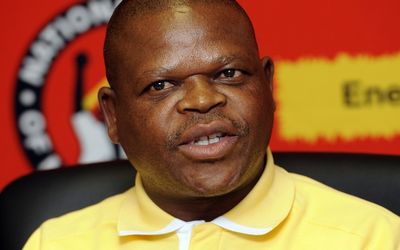WITH attention focused on the strike that began last week at the big three platinum producers, not much of a post-mortem was done on the lengthy industrial action that ended just the week before, at Northam Platinum.
Yet the Northam dispute holds clues for the parties involved in the big platinum strike on the go right now. As both labour and management anxiously weigh each other’s resolve for protracted strike action, it would be wise to look to the anatomy of the Northam dispute to discern what the parties can expect from each other.
The Northam strike is itself remarkable. At 77 days, it has been, as far as many industrial relations practitioners and unionists can recount, the longest wage strike in post-apartheid labour history.
Unpacking why workers were so determined to strike for so long is also revealing of the dynamics in the labour movement and the factors driving them.
So, what was the wage demand?
As in the current strike, where demand is higher than double the present rate, the wage demand by the National Union of Mineworkers (NUM) at Northam was also incredibly high.
The union asked for an increase of R2,100 on basic wages for core workers, which was equivalent to about 23% on the base rate.
Management’s offer was 7.5% for core workers, which it raised to 8% on the eve of the strike. After two days, management improved its offer to 9%.
This was rejected by the NUM, which then suffered the consequence of waiting another 11 weeks for a further offer. This — only another 0.5% — was the offer that settled the strike, which means that workers struck out for a further 75 days for 0.5% gain.
In that period they lost nearly 25% of their yearly wages.
The NUM’s explanation for the long and largely fruitless strike is the intransigence of Northam management. Historically, industrial relations at Northam have been fraught, with frequent strikes over wages, some lasting as long as six weeks. The leader of negotiations for the NUM, Ecliff Tantsi, says "Northam is a war zone."
"The attitude of workers is: ‘We don’t care how much we get as long as we fight. We will fight because we are angry,’" he says.
While conflictual industrial relations do seem a factor, the reality is that Northam management upped its offer three times prior to workers digging in, while the NUM did little to adjust its demand.
This casts some doubt on the NUM’s explanation that the strike was all due to an intransigent management that displayed no will to settle the dispute. Northam’s offer prior to the strike was also higher than the settlement of 8% in gold several months before and, with inflation at under 6%, was not a bad offer in light of poor industry economic circumstances.
The looming larger dispute between the Association of Mineworkers and Construction Union (Amcu) and the big three producers was clearly the main consideration at play for both sides. On the one hand, the NUM is engaged in a fight for survival against Amcu on the platinum belt, and has needed to demonstrate its militancy.
Amcu has secured 20% of Northam’s workforce so far, and the NUM branch officials faced the horrible prospect of losing their ascendancy (and associated privileges) should Northam workers be awarded less than those organised by Amcu at other mines. Similarly, Northam management were aware that the industry as a whole was looking to it to hold the line and contain the increase to a single digit.
What the majority of workers felt was never completely clear. As is common practice, all strike decisions were taken in mass meetings, where a handful of militants tend to set the tone, while most workers listen. The atmosphere is not one where dissenting voices are encouraged or would find it easy, or even wise, to speak out.
The result was a damaging battle of wills in which Northam revenue losses are estimated at R749.7m and employees lost R151.7m in wages.
The NUM has been at pains to make out that the strike achieved more than it really did. In addition to the 9.5% settlement, Northam management offered a R3,000 ex gratia payment to help workers get back on their feet and pay for basic necessities after the strike.
Both Mr Tantsi and the NUM general secretary Frans Baleni insist that this amount will also be added to the baseline after the two-agreement expires. To make things look better for workers, the NUM has insisted that for lower category workers, part of the ex gratia payment is paid over the period as part of the monthly wage. But this is a fiction and the agreement quite clearly shows that R3,000 is a one-off payment and not an addition to the base rate salary.
In light of Northam, the lesson to management at Lonmin, Impala and Amplats would be to make a new offer soon to provide a way out of the dispute. To Amcu, whose members are already fatigued from strike action at Amplats and are divided, the lesson would be to accept a multi-year agreement quickly and move on.
There is also a lesson in it for the government. Decision-making by mass meeting in a context where trade unions are involved in power struggles that have little to do with that workplace are not in the interests of workers or employers. Compulsory strike balloting should be required in the interests of fairness and industrial peace.

National Union of Mineworkers general secretary Frans Baleni. Picture: FINANCIAL MAIL
WITH attention focused on the strike that began last week at the big three platinum producers, not much of a post-mortem was done on the lengthy industrial action that ended just the week before, at Northam Platinum.
Yet the Northam dispute holds clues for the parties involved in the big platinum strike on the go right now. As both labour and management anxiously weigh each other’s resolve for protracted strike action, it would be wise to look to the anatomy of the Northam dispute to discern what the parties can expect from each other.
The Northam strike is itself remarkable. At 77 days, it has been, as far as many industrial relations practitioners and unionists can recount, the longest wage strike in post-apartheid labour history.
Unpacking why workers were so determined to strike for so long is also revealing of the dynamics in the labour movement and the factors driving them.
So, what was the wage demand?
As in the current strike, where demand is higher than double the present rate, the wage demand by the National Union of Mineworkers (NUM) at Northam was also incredibly high.
The union asked for an increase of R2,100 on basic wages for core workers, which was equivalent to about 23% on the base rate.
Management’s offer was 7.5% for core workers, which it raised to 8% on the eve of the strike. After two days, management improved its offer to 9%.
This was rejected by the NUM, which then suffered the consequence of waiting another 11 weeks for a further offer. This — only another 0.5% — was the offer that settled the strike, which means that workers struck out for a further 75 days for 0.5% gain.
In that period they lost nearly 25% of their yearly wages.
The NUM’s explanation for the long and largely fruitless strike is the intransigence of Northam management. Historically, industrial relations at Northam have been fraught, with frequent strikes over wages, some lasting as long as six weeks. The leader of negotiations for the NUM, Ecliff Tantsi, says "Northam is a war zone."
"The attitude of workers is: ‘We don’t care how much we get as long as we fight. We will fight because we are angry,’" he says.
While conflictual industrial relations do seem a factor, the reality is that Northam management upped its offer three times prior to workers digging in, while the NUM did little to adjust its demand.
This casts some doubt on the NUM’s explanation that the strike was all due to an intransigent management that displayed no will to settle the dispute. Northam’s offer prior to the strike was also higher than the settlement of 8% in gold several months before and, with inflation at under 6%, was not a bad offer in light of poor industry economic circumstances.
The looming larger dispute between the Association of Mineworkers and Construction Union (Amcu) and the big three producers was clearly the main consideration at play for both sides. On the one hand, the NUM is engaged in a fight for survival against Amcu on the platinum belt, and has needed to demonstrate its militancy.
Amcu has secured 20% of Northam’s workforce so far, and the NUM branch officials faced the horrible prospect of losing their ascendancy (and associated privileges) should Northam workers be awarded less than those organised by Amcu at other mines. Similarly, Northam management were aware that the industry as a whole was looking to it to hold the line and contain the increase to a single digit.
What the majority of workers felt was never completely clear. As is common practice, all strike decisions were taken in mass meetings, where a handful of militants tend to set the tone, while most workers listen. The atmosphere is not one where dissenting voices are encouraged or would find it easy, or even wise, to speak out.
The result was a damaging battle of wills in which Northam revenue losses are estimated at R749.7m and employees lost R151.7m in wages.
The NUM has been at pains to make out that the strike achieved more than it really did. In addition to the 9.5% settlement, Northam management offered a R3,000 ex gratia payment to help workers get back on their feet and pay for basic necessities after the strike.
Both Mr Tantsi and the NUM general secretary Frans Baleni insist that this amount will also be added to the baseline after the two-agreement expires. To make things look better for workers, the NUM has insisted that for lower category workers, part of the ex gratia payment is paid over the period as part of the monthly wage. But this is a fiction and the agreement quite clearly shows that R3,000 is a one-off payment and not an addition to the base rate salary.
In light of Northam, the lesson to management at Lonmin, Impala and Amplats would be to make a new offer soon to provide a way out of the dispute. To Amcu, whose members are already fatigued from strike action at Amplats and are divided, the lesson would be to accept a multi-year agreement quickly and move on.
There is also a lesson in it for the government. Decision-making by mass meeting in a context where trade unions are involved in power struggles that have little to do with that workplace are not in the interests of workers or employers. Compulsory strike balloting should be required in the interests of fairness and industrial peace.
























Post a comment